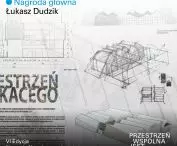Grand Prize
category: theoretical master's thesis
PLN 10,000
author
Łukasz Dudzik
Title
"Rooted Architecture. Tradition in design thinking. Design of an exhibition pavilion based on the solutions of regional architecture - Witkacy's Space".
university
Faculty of Interior Design, Jan Matejko Academy of Fine Arts in Kraków.
supervisor
Dr. Patrycja Ochman-Tarka
Jury opinion
Mr. Łukasz Dudzik, M.A., took up the problem of rooted architecture as a special kind of common good, taking as a case study the arrangement of an exhibition pavilion called Witkacy's Space. Its architecture was founded on the tradition of regional / Podhale / vernacular construction and the Zakopane style, created by Witkacy's father, the painter and art critic Stanislaw Witkiewicz. The author focuses on the complex aspects of using this tradition to create an exhibition architecture representative of the 21st century, taking into account its duties, the needs and expectations of its users and viewers, and the relationship between them and the site. Here the author draws on local traditions and recalls the experience of contemporary architecture (Peter Zumthor), especially Japanese architecture, for which the work of architect and architectural theorist Kengo Kuma is representative. For Lukasz Dudzik, the East Asian way of thinking about architecture carries universal values in understanding the essence of rooted architecture and its practice today. In this context, the author recalls one of the leading European modernists, Bruno Taut and his Hyuga Villa in Atami, Japan (1935-36), which combines components of the traditional Japanese house and its aesthetic with Western aesthetics. Now this proximity to the Far East is discounted by Lukasz Dudzik, recognizing Kenzo Kuma's 5 design principles as a universal method of the design process: 1/ openness/ openness; 2/ particle/ complexity; 3/ softness; 4/ time; 5/ slant/ slope. M.A. Dudzik finds these principles in the regional buildings of the Podhale region, and on this he develops the concept of Witkacy's Space as a rooted place with a strong emotional charge, with references to thepersonality of the author of this work, who consciously avoids the notion of a museum and emphasizes that his concept "is meant to be an experience that combines various exhibition techniques, both analog and digital, building a theatrical immersion of the place. An interactive experience that brings universal content to life by confronting it, and creates the visitor as a participant in living history from the past." The leitmotif of the exhibition is a multidimensional experience that allows visitors to penetrate the emotions of historical figures and even identify with them. Therefore, the scenario of the exhibition is based on the scheme of a 3-act theater drama depicting the life and work of Witkacy.
Methodologically, the work represents modern thinking about what today is rooted architecture and modern museum exhibition and its pedagogy, which situates the work in the field of contemporary cultural, sociological andnew art practices by an artist-researcher (ABR - art-based-research), who uses hybrid artistic processes to investigate, understand, represent and even question human action and experience, thus blurring the boundaries between disciplines (art versus science) and functionalizing them in the social construction of knowledge.













